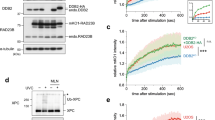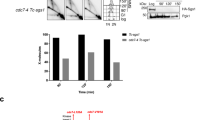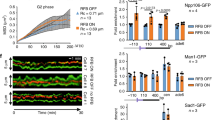Abstract
Post-replication repair (PRR) is a pathway that allows cells to bypass or overcome lesions during DNA replication1. In eukaryotes, damage bypass is activated by ubiquitylation of the replication clamp PCNA through components of the RAD6 pathway2. Whereas monoubiquitylation of PCNA allows mutagenic translesion synthesis by damage-tolerant DNA polymerases3,4,5, polyubiquitylation is required for an error-free pathway that probably involves a template switch to the undamaged sister chromatid6. Both the timing of PRR events during the cell cycle and their location relative to replication forks, as well as the factors required downstream of PCNA ubiquitylation, have remained poorly characterized. Here we demonstrate that the RAD6 pathway normally operates during S phase. However, using an inducible system of DNA damage bypass in budding yeast (Saccharomyces cerevisiae), we show that the process is separable in time and space from genome replication, thus allowing direct visualization and quantification of productive PRR tracts. We found that both during and after S phase ultraviolet-radiation-induced lesions are bypassed predominantly via translesion synthesis, whereas the error-free pathway functions as a backup system. Our approach has revealed the distribution of PRR tracts in a synchronized cell population. It will allow an in-depth mechanistic analysis of how cells manage the processing of lesions to their genomes during and after replication.
This is a preview of subscription content, access via your institution
Access options
Subscribe to this journal
Receive 51 print issues and online access
$199.00 per year
only $3.90 per issue
Buy this article
- Purchase on Springer Link
- Instant access to full article PDF
Prices may be subject to local taxes which are calculated during checkout




Similar content being viewed by others
References
Lawrence, C. The RAD6 DNA repair pathway in Saccharomyces cerevisiae: what does it do, and how does it do it? Bioessays 16, 253–258 (1994)
Hoege, C., Pfander, B., Moldovan, G. L., Pyrowolakis, G. & Jentsch, S. RAD6-dependent DNA repair is linked to modification of PCNA by ubiquitin and SUMO. Nature 419, 135–141 (2002)
Kannouche, P. L., Wing, J. & Lehmann, A. R. Interaction of human DNA polymerase η with monoubiquitinated PCNA: a possible mechanism for the polymerase switch in response to DNA damage. Mol. Cell 14, 491–500 (2004)
Stelter, P. & Ulrich, H. D. Control of spontaneous and damage-induced mutagenesis by SUMO and ubiquitin conjugation. Nature 425, 188–191 (2003)
Watanabe, K. et al. Rad18 guides pol η to replication stalling sites through physical interaction and PCNA monoubiquitination. EMBO J. 23, 3886–3896 (2004)
Zhang, H. & Lawrence, C. W. The error-free component of the RAD6/RAD18 DNA damage tolerance pathway of budding yeast employs sister-strand recombination. Proc. Natl Acad. Sci. USA 102, 15954–15959 (2005)
di Caprio, L. & Cox, B. S. DNA synthesis in UV-irradiated yeast. Mutat. Res. 82, 69–85 (1981)
Lehmann, A. R. Postreplication repair of DNA in ultraviolet-irradiated mammalian cells. J. Mol. Biol. 66, 319–337 (1972)
Prakash, L. Characterization of postreplication repair in Saccharomyces cerevisiae and effects of rad6, rad18, rev3 and rad52 mutations. Mol. Gen. Genet. 184, 471–478 (1981)
Lopes, M., Foiani, M. & Sogo, J. M. Multiple mechanisms control chromosome integrity after replication fork uncoupling and restart at irreparable UV lesions. Mol. Cell 21, 15–27 (2006)
Edmunds, C. E., Simpson, L. J. & Sale, J. E. PCNA ubiquitination and REV1 define temporally distinct mechanisms for controlling translesion synthesis in the avian cell line DT40. Mol. Cell 30, 519–529 (2008)
Davies, A. A., Huttner, D., Daigaku, Y., Chen, S. & Ulrich, H. D. Activation of ubiquitin-dependent DNA damage bypass is mediated by Replication Protein A. Mol. Cell 29, 625–636 (2008)
Janke, C. et al. A versatile toolbox for PCR-based tagging of yeast genes: new fluorescent proteins, more markers and promoter substitution cassettes. Yeast 21, 947–962 (2004)
Belli, G., Gari, E., Piedrafita, L., Aldea, M. & Herrero, E. An activator/repressor dual system allows tight tetracycline-regulated gene expression in budding yeast. Nucleic Acids Res. 26, 942–947 (1998)
Waters, L. S. & Walker, G. C. The critical mutagenic translesion DNA polymerase Rev1 is highly expressed during G(2)/M phase rather than S phase. Proc. Natl Acad. Sci. USA 103, 8971–8976 (2006)
Garg, P. & Burgers, P. M. Ubiquitinated proliferating cell nuclear antigen activates translesion DNA polymerases η and REV1. Proc. Natl Acad. Sci. USA 102, 18361–18366 (2005)
Haracska, L., Unk, I., Prakash, L. & Prakash, S. Ubiquitylation of yeast proliferating cell nuclear antigen and its implications for translesion DNA synthesis. Proc. Natl Acad. Sci. USA 103, 6477–6482 (2006)
Viggiani, C. J. & Aparicio, O. M. New vectors for simplified construction of BrdU-incorporating strains of Saccharomyces cerevisiae . Yeast 23, 1045–1051 (2006)
Parker, J. L., Bielen, A. B., Dikic, I. & Ulrich, H. D. Contributions of ubiquitin- and PCNA-binding domains to the activity of Polymerase η in Saccharomyces cerevisiae . Nucleic Acids Res. 35, 881–889 (2007)
MacAlpine, D. M. & Bell, S. P. A genomic view of eukaryotic DNA replication. Chromosome Res. 13, 309–326 (2005)
Hishida, T., Kubota, Y., Carr, A. M. & Iwasaki, H. RAD6–RAD18–RAD5-pathway-dependent tolerance to chronic low-dose ultraviolet light. Nature 457, 612–615 (2009)
Resnick, M. A. & Setlow, J. K. Repair of pyrimidine dimer damage induced in yeast by ultraviolet light. J. Bacteriol. 109, 979–986 (1972)
Unrau, P., Wheatcroft, R., Cox, B. & Olive, T. The formation of pyrimidine dimers in the DNA of fungi and bacteria. Biochim. Biophys. Acta 312, 626–632 (1973)
Prakash, S., Johnson, R. E. & Prakash, L. Eukaryotic translesion synthesis DNA polymerases: specificity of structure and function. Annu. Rev. Biochem. 74, 317–353 (2004)
Bresson, A. & Fuchs, R. P. P. Lesion bypass in yeast cells: Polη participates in a multi-DNA polymerase process. EMBO J. 21, 3881–3887 (2002)
Johnson, R. E., Washington, M. T., Haracska, L., Prakash, S. & Prakash, L. Eukaryotic polymerases ι and ζ act sequentially to bypass DNA lesions. Nature 406, 1015–1019 (2000)
Shachar, S. et al. Two-polymerase mechanisms dictate error-free and error-prone translesion DNA synthesis in mammals. EMBO J. 28, 383–393 (2009)
Papouli, E. et al. Crosstalk between SUMO and ubiquitin on PCNA is mediated by recruitment of the helicase Srs2p. Mol. Cell 19, 123–133 (2005)
Liang, C. & Stillman, B. Persistent initiation of DNA replication and chromatin-bound MCM proteins during the cell cycle in cdc6 mutants. Genes Dev. 11, 3375–3386 (1997)
Jackson, D. A. & Pombo, A. Replicon clusters are stable units of chromosome structure: evidence that nuclear organization contributes to the efficient activation and propagation of S phase in human cells. J. Cell Biol. 140, 1285–1295 (1998)
Acknowledgements
We thank O. Aparicio for plasmid p306-BrdU-Inc and the laboratory of V. Costanzo for advice on DNA fibre analysis. This work was funded by Cancer Research UK.
Author information
Authors and Affiliations
Contributions
Y.D. and A.A.D. performed the experiments; Y.D. and H.D.U. designed the study; H.D.U. wrote the manuscript. All authors discussed the results and commented on the manuscript.
Corresponding author
Ethics declarations
Competing interests
The authors declare no competing financial interests.
Supplementary information
Supplementary Information
This file contains Supplementary Figures S1-S9 with legends, References and Supplementary Table S1. (PDF 2645 kb)
Rights and permissions
About this article
Cite this article
Daigaku, Y., Davies, A. & Ulrich, H. Ubiquitin-dependent DNA damage bypass is separable from genome replication. Nature 465, 951–955 (2010). https://doi.org/10.1038/nature09097
Received:
Accepted:
Published:
Issue Date:
DOI: https://doi.org/10.1038/nature09097
This article is cited by
-
Reconstitution of translesion synthesis reveals a mechanism of eukaryotic DNA replication restart
Nature Structural & Molecular Biology (2020)
-
Distinct requirements for budding yeast Rev1 and Polη in translesion DNA synthesis across different types of DNA damage
Current Genetics (2020)
-
Sgs1 helicase is required for efficient PCNA monoubiquitination and translesion DNA synthesis in Saccharomyces cerevisiae
Current Genetics (2018)
-
The control of DNA repair by the cell cycle
Nature Cell Biology (2017)
-
DNA replication stress: from molecular mechanisms to human disease
Chromosoma (2017)
Comments
By submitting a comment you agree to abide by our Terms and Community Guidelines. If you find something abusive or that does not comply with our terms or guidelines please flag it as inappropriate.



